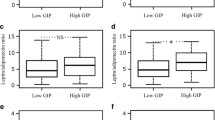Abstract
WNT1 inducible signaling pathway protein 1 (WISP-1/CCN4) is a novel adipokine, which is upregulated in obesity, and induces a pro-inflammatory response in macrophages in-vitro. Preclinical observations suggested WISP-1/CCN4 as a potential candidate for novel obesity therapy targeting adipose tissue inflammation. Whether circulating levels of WISP-1/CCN4 in humans are altered in obesity and/or type 2 diabetes (T2DM) and in the postprandial state, however, is unknown. This study assessed circulating WISP-1/CCN4 levels in a) paired liquid meal tests and hyperinsulinemic- euglycemic clamps (cohort I, n = 26), b) healthy individuals (cohort II, n = 207) and c) individuals with different stages of obesity and glucose tolerance (cohort III, n = 253). Circulating plasma and serum WISP-1/CCN4 concentrations were measured using a commercially available ELISA. WISP-1/CCN4 levels were not influenced by changes in insulin and/or glucose during the tests. In healthy individuals, WISP-1/CCN4 was detectable in 13% of plasma samples with the intraclass correlation coefficient of 0.93 (95% CI: 0.84–0.96) and in 58.1% of the serum samples in cohort III. Circulating WISP-1/CCN4 positively correlated with body mass index, body fat percentage, leptin and triglyceride levels, hip circumference and fatty liver index. No differences in WISP-1/CCN4 levels between individuals with normal glucose tolerance, impaired glucose tolerance and T2DM were found. The circulating concentrations of WISP-1/CCN4 showed no acute regulation in postprandial state and correlated with anthropometrical obesity markers and lipid profiles. In healthy individuals, WISP-1/CCN4 levels are more often below the detection limit. Thus, serum WISP-1/CCN4 levels may be used as a suitable biomarker of obesity.



Similar content being viewed by others
Abbreviations
- ALT:
-
Alanine transaminase
- CCN:
-
CTGF/Cyr61/Nov) family proteins
- EPIC:
-
European Prospective Investigation into Cancer and Nutrition
- FLI:
-
Fatty Liver Index
- HOMA-IR:
-
Homeostatic model assessment insulin resistance
- HEC:
-
Hyperinsulinemic euglycemic clamp
- IFG:
-
Impaired fasting glucose
- IGT:
-
Impaired glucose tolerance
- IHL:
-
Intrahepatic liver fat
- LMCT:
-
Liquid meal challenges tests
- NGT:
-
Normal glucose tolerance
- T2DM:
-
Type 2 diabetes mellitus
- VAT:
-
Visceral adipose tissue
- WHR:
-
Waist-to-hip ratio
- WISP-1/CCN4:
-
WNT-inducible signaling pathway protein-1
References
Abell SK, De Courten B, Boyle JA, Teede HJ (2015) Inflammatory and Other Biomarkers: Role in Pathophysiology and Prediction of Gestational Diabetes Mellitus. Int J Mol Sci 16:13442–13473
Barchetta I, Cimini FA, Capoccia D, De Gioannis R, Porzia A, Mainiero F, Di Martino M, Bertoccini L, De Bernardinis M, Leonetti F et al (2017) WISP1 Is a Marker of Systemic and Adipose Tissue Inflammation in Dysmetabolic Subjects With or Without Type 2 Diabetes. J Endocrine Society 1:660–670
Bedogni G, Bellentani S, Miglioli L, Masutti F, Passalacqua M, Castiglione A, Tiribelli C (2006) The Fatty Liver Index: a simple and accurate predictor of hepatic steatosis in the general population. BMC Gastroenterol 6:33
Berschneider B, Konigshoff M (2011) WNT1 inducible signaling pathway protein 1 (WISP1): a novel mediator linking development and disease. Int J Biochem Cell Biol 43:306–309
Blom AB, Brockbank SM, van Lent PL, van Beuningen HM, Geurts J, Takahashi N, van der Kraan PM, van de Loo FA, Schreurs BW, Clements K et al (2009) Involvement of the Wnt signaling pathway in experimental and human osteoarthritis: prominent role of Wnt-induced signaling protein 1. Arthritis Rheum 60:501–512
Brigstock DR (2003) The CCN family: a new stimulus package. J Endocrinol 178:169–175
Catalano PM, Kirwan JP, Haugel-de Mouzon S, King J (2003) Gestational diabetes and insulin resistance: role in short- and long-term implications for mother and fetus. J Nutr 133:1674S–1683S
Gurbuz I, Chiquet-Ehrismann R (2015) CCN4/WISP1 (WNT1 inducible signaling pathway protein 1): a focus on its role in cancer. Int J Biochem Cell Biol 62:142–146
Gustafson B, Hammarstedt A, Hedjazifar S, Smith U (2013) Restricted adipogenesis in hypertrophic obesity: the role of WISP2, WNT, and BMP4. Diabetes 62:2997–3004
Holbourn KP, Acharya KR, Perbal B (2008) The CCN family of proteins: structure-function relationships. Trends Biochem Sci 33:461–473
Jun JI, Lau LF (2011) Taking aim at the extracellular matrix: CCN proteins as emerging therapeutic targets. Nat Rev Drug Discov 10:945–963
Leask A, Abraham DJ (2006) All in the CCN family: essential matricellular signaling modulators emerge from the bunker. J Cell Sci 119:4803–4810
Liu J, Ren Y, Kang L, Zhang L (2014) Overexpression of CCN3 inhibits inflammation and progression of atherosclerosis in apolipoprotein E-deficient mice. PLoS One 9:e94912
Murahovschi V, Pivovarova O, Ilkavets I, Dmitrieva RM, Docke S, Keyhani-Nejad F, Gogebakan O, Osterhoff M, Kemper M, Hornemann S et al (2015a) WISP1 Is a Novel Adipokine Linked to Inflammation in Obesity. Diabetes 64:856–866
Murahovschi VTC, Pivovarova O, Kruse M, Seltmann AC, Kemper M, Hornemann S, Pfeiffer AFH, Rudovich N (2015b) Regulation of WNT signaling receptors and co-receptors by high fat diet in humans. Exp Clin Endocrinol Diabetes 123:P08_02
Pakradouni J, Le Goff W, Calmel C, Antoine B, Villard E, Frisdal E, Abifadel M, Tordjman J, Poitou C, Bonnefont-Rousselot D et al (2013) Plasma NOV/CCN3 levels are closely associated with obesity in patients with metabolic disorders. PLoS One 8:e66788
Perbal B (2009) Alternative splicing of CCN mRNAs .... it has been upon us. J Cell Commun Signal 3:153–157
Riboli E, Hunt KJ, Slimani N, Ferrari P, Norat T, Fahey M, Charrondiere UR, Hemon B, Casagrande C, Vignat J et al (2002) European Prospective Investigation into Cancer and Nutrition (EPIC): study populations and data collection. Public Health Nutr 5:1113–1124
Rudovich NN, Weickert MO, Pivovarova O, Bernigau W, Pfeiffer AF (2011) Effects of acarbose treatment on markers of insulin sensitivity and systemic inflammation. Diabetes Technol Ther 13:615–623
Sahin Ersoy G, Altun Ensari T, Subas S, Giray B, Simsek EE, Cevik O (2016) WISP1 is a novel adipokine linked to metabolic parameters in gestational diabetes mellitus. J Matern Fetal Neonatal Med 30:1–5
Stephens S, Palmer J, Konstantinova I, Pearce A, Jarai G, Day E (2015) A functional analysis of Wnt inducible signalling pathway protein −1 (WISP-1/CCN4). J Cell Commun Signal 9:63–72
Tanaka S, Sugimachi K, Saeki H, Kinoshita J, Ohga T, Shimada M, Maehara Y, Sugimachi K (2001) A novel variant of WISP1 lacking a Von Willebrand type C module overexpressed in scirrhous gastric carcinoma. Oncogene 20:5525–5532
WHO (2006) Definition and Diagnosis of Diabetes Mellitus and Intermediate Hyperglycemia. World Health Organization, Geneva, pp 1–46
Yanagita T, Kubota S, Kawaki H, Kawata K, Kondo S, Takano-Yamamoto T, Tanaka S, Takigawa M (2007) Expression and physiological role of CCN4/Wnt-induced secreted protein 1 mRNA splicing variants in chondrocytes. FEBS J 274:1655–1665
Zhong X, Tu YJ, Li Y, Zhang P, Wang W, Chen SS, Li L, Chung AC, Lan HY, Chen HY et al (2017) Serum levels of WNT1-inducible signaling pathway protein-1 (WISP-1): a noninvasive biomarker of renal fibrosis in subjects with chronic kidney disease. Am J Transl Res 9:2920–2932
Zhou Y, Yu X, Chen H, Sjoberg S, Roux J, Zhang L, Ivoulsou AH, Bensaid F, Liu CL, Liu J et al (2015) Leptin Deficiency Shifts Mast Cells toward Anti-Inflammatory Actions and Protects Mice from Obesity and Diabetes by Polarizing M2 Macrophages. Cell Metab 22:1045–1058
Acknowledgements
We thank all study participants for their cooperation. We thank the Human Study Centre at the DIfE for data collection and biological sample logistics. We express thanks to Dr. Manuela Bergmann for her contribution by leading the underlying processes of data generation, as well as to Silke Navia Fruth and Herbert Piechot for their valuable assistance with biosamples management. Particular thanks are given to the EPIC Potsdam data manager - Ellen Kohlsdorf. We gratefully acknowledge the excellent technical assistance of Katrin Sprengel, and Tanja Ahrens. We thank Stephanie Sucher for her extensive advice regarding nutritional counselling and June Inderthal for reading and correcting the manuscript.
Funding
This work was financially supported by grant from German Diabetes Center (DZD) (NR, DMO) and grant of European Foundation for Study of Diabetes (EFSD) (NR, DMO). The funding source had no role in study design, data collection, analysis or interpretation, report writing, or the decision to submit this paper for publication.
Author information
Authors and Affiliations
Contributions
Study concept and design: AFHP, OP, and NR. Acquisition of data: CT, KA, TH, MK, SH, CG and SK. Analysis and interpretation of data: CT, KA, DMO, VM, MM, CG, MR, DMO, TH, MOW, HB, AFHP, OP, and NR. Drafting of the manuscript: CT, AFHP, OP, and NR. Critical revision of the manuscript: CT, KA, MR, VM, MM, MK, SH, UK, CH, SK, TH, DMO, MOW, HB, AFHP, OP and NR. Obtained funding: DMO and NR. All authors contributed to and approved the final version of the manuscript. AFHP, OP, and NR are the guarantors of this work and as such had full access to all the data in the study and take responsibility for the integrity of the data and the accuracy of the data analysis.
Corresponding author
Ethics declarations
Duality of interest
The authors declare that there is no duality of interest associated with this manuscript.
Conflict of interest
The authors declare no conflict of interest.
Additional information
Some of the data were presented as abstracts at the D·A·CH meeting 2015 and at the European Association for the Study of Diabetes annual meeting in 2016.
Rights and permissions
About this article
Cite this article
Tacke, C., Aleksandrova, K., Rehfeldt, M. et al. Assessment of circulating Wnt1 inducible signalling pathway protein 1 (WISP-1)/CCN4 as a novel biomarker of obesity. J. Cell Commun. Signal. 12, 539–548 (2018). https://doi.org/10.1007/s12079-017-0427-1
Received:
Accepted:
Published:
Issue Date:
DOI: https://doi.org/10.1007/s12079-017-0427-1




